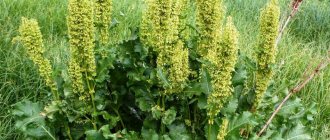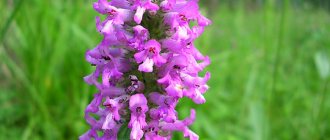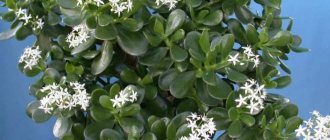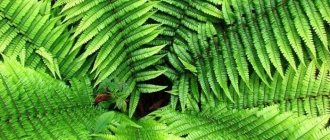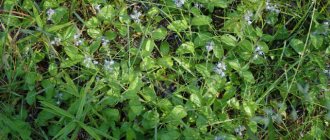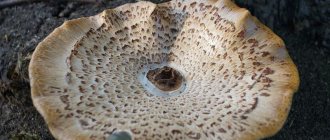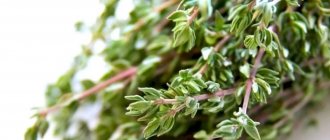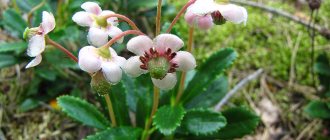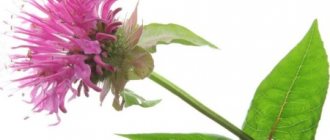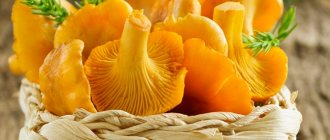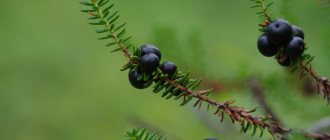What it looks like and where it grows
Thuja is a coniferous plant from the Cypress family, which is very popular in ornamental cultivation. It is an evergreen shrub or tree with a maximum height in nature of up to 70 m, the crown can spread over 2.5-6 m. The leaves of a young thuja are needle-shaped, soft, while those of an adult are in the form of scales. It produces shoots of two types - growth shoots, located symmetrically radially, with long internodes, and trophic shoots, flattened type with branching in one plane. Thuja bears oval or oblong cones with flat seeds.
Decorative thuja grows to a maximum of 10 m
It grows naturally in North America and southeastern Canada. Artificial coniferous trees and shrubs are grown all over the world in parks and garden plots. You can meet thuja in Russia not only in the Moscow region, but also in Siberia; it tolerates cold weather well and feels comfortable on any soil.
Option 1. Old arborvitae and cypress trees
Conifers begin to bear fruit from 5-10 years of age (depending on the variety and species), reaching a height of only 0.5-1 m. And then regularly every 1-2 years they produce a large harvest of seeds - that is, they form a lot of cones.
In young, low-growing plants, it is enough to trim off infrequently formed cones along with dry and damaged shoots at least once a year.
As for adult conifers, they definitely need annual spring pruning. With the onset of the first heat (usually in March) and before new shoots begin to grow, trees should be rid of old dry and thickening branches and a decorative crown should be formed. In August, if necessary, the procedure is repeated, at the same time removing excess cones.
What to do ? Regular sanitary and formative pruning will help you.
- Master class: topiary haircut of thuja
Three shapes of DIY topiary: spiral, cone and column.
Chemical composition
The beneficial properties of thuja for the human body are explained by its rich composition. Shoots, cones and seeds of the bush contain:
- resins;
- ascorbic acid;
- saponins and glycosides;
- sesquiterpene alcohols;
- flavonoids;
- thuic acid;
- tannins and tannins;
- essential oils;
- phytoncides;
- pentoxifylline;
- aromadendren;
- mineral salts.
Thuja also contains thujone, a neutrotropic toxin. In small quantities it can be beneficial, but in overdose it poses a great danger to the body.
Attention! Thujone is used in the production of absinthe, one of the strongest alcoholic drinks.
Why do cones appear on thujas?
On a thuja that has reached the age of 12–15 years, unusual yellow-green growths appear, and an inexperienced plant grower will not immediately understand that these are ordinary cones (fruits) . They are not very similar to the usual spruce or pine seeds, since they are much smaller in size, but they serve the same purpose: they produce seeds that will reproduce in future generations.
Important! Pruning to maintain the given shape of the thuja can only be done on green and pliable young stems.
This crop is not characterized by annual fruiting; most likely it will occur once every 2–5 years. The testes are round, slightly flattened, and consist of tightly fitted scales. After final formation, they reach a width of 3-3.5 mm and a length of 2-3 mm. The buds will not be yellow-green throughout the growing season.
At the beginning of autumn they turn brown, which signals full maturity, and then open, releasing the seeds. The fruits will remain on the branches all winter, but will eventually fall to the ground.
What are the benefits of thuja for human health?
The beneficial properties of Crimean thuja and other plant species are very diverse. Fruits and seeds of the bush, when consumed correctly:
- have a tonic and calming effect;
- relieve inflammation and fight bacterial infections;
- serve as cancer prevention;
- have an antirheumatic effect and help with joint pain;
- promote the regeneration of skin damage;
- relieve swelling due to diuretic properties;
- have antiviral and antifungal effects;
- promote expectoration during cough and bronchitis;
- relieve fatigue and help fight insomnia.
Indications for the use of thuja include vitamin deficiency and anemia. The plant saturates the body with valuable substances and is especially beneficial during the cold season. Herbal preparations also help fight allergies.
What are the benefits of thuja cones?
Young thuja cones have pronounced sedative properties, promote relaxation and relieve fatigue. Products based on them are used to eliminate muscle spasms and to prevent and treat viral infections. Thuja tinctures and decoctions strengthen the immune system, improve oxygen circulation in the body, and promote rapid cell renewal.
We recommend reading: Tea with thyme: beneficial properties and contraindications
Tannins in thuja buds help with intestinal disorders
What does thuja tincture with alcohol and vodka help with?
In an alcohol base, the beneficial substances in thuja are preserved especially well. The finished product is considered universal and has a wide range of valuable properties, namely:
- relieves swelling due to its diuretic effect;
- promotes expectoration;
- accelerates the flow of bile;
- relieves inflammatory processes in pyelonephritis and liver diseases;
- eliminates pain from rheumatism and gout.
Alcohol tincture of thuja is used internally, as well as for rubbing, compresses and rinsing.
What does thuja infusion help with?
An aqueous infusion of young shoots is used for liver and kidney diseases. The product relieves inflammation well and promotes the removal of hard stones from internal organs. The drink can also be used for bleeding and gynecological diseases to eliminate infections.
Important! Thuja infusion has anthelmintic properties and is used for intestinal parasites.
What is thuja decoction useful for?
Thuja decoction is considered less useful than tincture or infusion, since some of the valuable substances in it are destroyed during heat treatment. But with proper preparation, such a product still retains many vitamin components. Thuja decoction is used mainly externally to disinfect injuries. It can also be taken internally as an expectorant and disinfectant, and used for rinsing and healing baths.
The benefits of thuja brooms for baths
Fresh thuja shoots are used to create bath brooms. When used in a steam room, they help:
- strengthen the immune system and endurance of the body;
- relieve stress and restore strength;
- improve skin elasticity and relieve swelling;
- eliminate inflammation and acne.
The aroma emitted by pine brooms helps ease breathing during nasal congestion and has a beneficial effect on the bronchi and lungs.
If you have a cold with an elevated temperature, steaming with or without thuja brooms is not recommended
Medicinal properties
Young thuja cones have a lot of positive qualities . First of all, it has a calming effect on nerve receptors , no matter in what form the product is used (internally or externally). Aromatic extracts penetrate the brain centers through the nasal passages and promote relaxation, and, accordingly, improve overall well-being, relieve tension and muscle spasms.
- The main benefits of the raw materials in question are as follows:
- tropolones prevent the growth of cancer cells, which is an excellent cancer prevention;
- phytoncides and flavonoids stimulate the production of interferon, suppress the growth of bacteria and infections, and have a wound-healing effect;
- vitamins and minerals ensure restoration at the cellular level of all organ tissues and significantly increase immunity;
- due to the diuretic effect, stagnant processes are eliminated;
- air circulation in tissues improves;
- for problems with the respiratory tract, an expectorant effect is provided;
- Due to the effect on the nervous system, spasms are relieved and an analgesic effect is provided.
Also learn about the medicinal properties and uses of pine cones.
Methods of preparation and use
Based on thuja cones and shoots, traditional medicine prepares several effective medicines. They can be used externally or internally according to prescriptions.
Tincture of seeds, thuja cones in alcohol, vodka
For inflammatory and colds, you can prepare an infusion of thuja cones with vodka. They do it like this:
- 500 g of crushed raw materials are poured with 2 liters of good vodka;
- add four large spoons of liquid honey;
- mix and, covered, put away in a dark place for two weeks.
From time to time the tincture is taken out and shaken. After the expiration date, you need to strain it, and you need to use the product 15 drops on an empty stomach up to four times a day.
You can also make a medicine using alcohol. In this case, the recipe will look a little different:
- 30 g of crushed thuja cones and seeds are poured with 200 ml of 70% alcohol;
- seal and put in a darkened cabinet for 14 days;
- After the expiration date, strain.
The tincture is used according to a similar algorithm for problems with the outflow of bile, swelling and inflammation.
It is recommended to continue treatment with tincture of thuja cones for no more than two weeks in a row.
Infusion
A water infusion is prepared from young shoots of thuja. The recipe looks like this:
- 20 g of raw materials are crushed and 1 liter of hot liquid is poured;
- keep under the lid for four hours;
- filter before use.
You need to drink the infusion 200 ml up to three times a day. It is usually used as a diuretic and to remove worms.
Water infusion of thuja can be used to wipe cuts and ulcers
Decoction
A decoction with good anti-inflammatory properties is prepared from hard cones and dry thuja seeds. Traditional medicine offers the following recipe:
- 50 g of finely chopped raw materials are poured into 1 liter of cold water;
- bring to a boil and boil over low heat for 30 minutes;
- remove from the stove and keep covered until cool.
Strained thuja decoction is taken in small portions of 150-200 ml three times a day. The product can also be added to medicinal baths to relieve skin inflammation.
Thuja cones in the form of a decoction are good for calming the nerves and eliminating insomnia.
Contraindications and possible harm
It is worth understanding that the remedies in question will not be equally useful to everyone, but may be dangerous for some. Exceeding the dosage and using it for too long can cause problems with the gastrointestinal tract, allergic reactions in the form of urticaria, itching, and intoxication.
- The use of drugs based on thuja cones is completely contraindicated:
- pregnant women;
- children under 12 years old;
- allergy sufferers who have a history of reactions to any plants;
- epileptics.
Asthmatics are used with caution , only in cases where the cause of the disease is frequent viral infections of the upper respiratory tract, and in the absence of a history of reaction to herbal components.
The people's stock of knowledge, passed down from generation to generation, has brought to our time various recipes using thuja cones as a medicine for many diseases. If you use raw materials correctly, you can significantly increase the body's resistance to infections, improve the condition of the nervous system, and also restore the natural beauty and youth of the skin.
The use of thuja in folk medicine
The beneficial properties of thuja for treatment are used in recipes for a wide range of diseases. Traditional medicine offers several effective algorithms.
For herpes
The antiviral properties of thuja help to quickly cope with herpes and other infections. A tincture is prepared for treatment:
- pour two large spoons of young shoots with 250 ml of medical alcohol;
- put in a dark place for two weeks;
- strain when ready.
You need to use the product ten drops three times a day.
For thrush
The use of the healing properties of thuja is in demand for fungal diseases. To combat thrush in women, it is recommended to prepare the following infusion:
- a large spoonful of plant cones is poured into a thermos;
- pour 500 ml of boiling water;
- close and leave to infuse for an hour.
The strained product is cooled and used for douching and washing in the morning and evening. Treatment should be continued for a week.
For cystitis
The use of Western thuja in medicine is in demand for inflammatory diseases of the genitourinary system. The following tincture is good for cystitis:
- three large spoons of pine needles and seeds are poured with 200 ml of alcohol;
- close the vessel with a stopper and put it in a dark place for two weeks;
- Shake the container daily.
The resulting thuja tincture is filtered and poured into a clean bottle. You need to take the product twice a day on an empty stomach, a single dosage is 30 drops. For convenience, the drug is diluted in 100 ml of water.
Alcohol tincture of thuja helps with exacerbations of prostatitis and adenoma in men
For joint ailments
The use of thuja needles and plant seeds is in demand for arthritis and rheumatism. The remedy is done as follows:
- two large spoons of raw material are poured into 500 ml of hot water;
- leave covered for an hour;
- filter and cool.
You need to take the infusion 50 ml three times a day.
For hemorrhoids
Lotions with thuja infusion relieve inflammation and stop bleeding from hemorrhoids. Prepare the following remedy:
- pour 250 ml of boiling water over a large spoon of crushed cones;
- leave closed for an hour;
- filter and cool until warm.
Soak a cotton pad in the infusion, squeeze lightly and apply to the anus for half an hour. The procedure is carried out throughout the week in the evenings.
For gynecological infections
The medicinal properties of thuja help get rid of sexually transmitted diseases. In complex treatment the following remedy is used:
- 20 g of chopped fresh pine needles and shoots are poured into 1 liter of hot water;
- keep in a thermos closed for three hours;
- strain the sediment through cheesecloth.
The infusion should be drunk half a glass three times a day. It is also used for douching in the mornings and evenings.
For warts and papillomas
To remove warts, as well as for polyps and papillomas, thuja infused with vodka is used. The remedy is done like this:
- 45 g of seeds and crushed cones are poured with 150 ml of alcohol, vodka or even cologne;
- put in a dark place for two weeks;
- filter through cheesecloth.
Thuja tincture is used exclusively externally - you need to lubricate the skin daily.
Advice! For severe calluses and corns, the product is mixed in equal proportions with Vaseline. The ointment is applied to the affected areas with compresses in the evenings.
For gout
The anti-inflammatory properties of thuja relieve pain and swelling due to gout. The following infusion has a good effect:
- 20 g of young shoots are crushed;
- pour 1 liter of hot water;
- leave covered for four hours.
The strained product is consumed three times a day, 200 ml.
For kidney stones
The diuretic properties of thuja help remove small stones from the kidneys and bladder. The medicinal drug is made as follows:
- 40 g of crushed young shoots are poured into 2 liters of liquid;
- leave to infuse for 3-4 hours covered;
- filter.
You need to drink the infusion 150 ml three times a day on an empty stomach.
For uterine bleeding
The medicinal properties of the thuja tree are used to stop uterine and hemorrhoidal bleeding. Traditional medicine recommends the following remedy for preparation:
- pour 200 ml of hot liquid into a large spoon of crushed shoots;
- infuse in a closed thermos for an hour;
- strain from the sediment.
You need to take the drug 30 ml three times a day.
The infusion will also be beneficial for bronchial asthma and prostatitis in men.
Thuja: beneficial properties and contraindications
Thuja is one of the few plants that has such a wide range of effects. This evergreen plant is used to create the following medicines:
- tonic;
- immuno-strengthening;
- antiseptic;
- sedatives;
- hemostatic;
- anti-inflammatory;
- antirheumatic;
- regenerative;
- strengthening;
- antiallergic;
- diuretics;
- anti-carcinogenic;
- antiviral;
- antifungal;
- diuretics;
- nutritious.
The trees themselves produce antimicrobial substances. Thuja helps with coughs, inflammation, fatigue - just breathe in the pine air!
Before using medicinal products from thuja, read the instructions for use and consult your doctor. Due to the specific toxin thujone and other active substances they contain, they are contraindicated for pregnant and lactating women, small children, with personal intolerance to certain components of the drug or allergies to them, epilepsy, and excessive skin sensitivity.
Application in cosmetology
Home cosmetology uses mainly essential oil from thuja seeds. It has moisturizing and toning properties, cleanses the skin and prevents aging. Usually the oil is added in a volume of 2-3 drops to purchased or homemade masks and creams.
You can also use thuja squeeze in combination with any base for massage. The product helps fight cellulite, stretch marks and allergic rashes. The ether is added to shampoos and rubbed in its pure form into the hair roots - this helps stop hair loss.
For problem skin and weakened strands, you can use decoctions of the plant for washing and rinsing. It is not recommended to wipe your face with alcohol tincture, but you can use it to spot-cauterize pimples.
Vodka tincture
The preparation procedure is reduced to the following sequence of actions:
- Prepare thuja fruits (an alternative is fresh pine needles);
- Grind them;
- Place the resulting mass in a jar;
- Pour in vodka (the proportions of base and vodka are 1 tablespoon per 100 milliliters, respectively);
- Add natural honey at the rate of 1 tablespoon for every 500 milliliters of vodka (this step is optional; in case of individual intolerance to the beekeeping product, it should be excluded);
- Leave for half a month in a place isolated from direct sunlight (the composition should be stirred occasionally);
- Strain;
- Start using: single volume – 5 drops (the product is diluted with water), frequency – three times a day, the best time is half an hour before meals.
Article for you:
Pine cones: medicinal properties and contraindications, use in folk medicine and cosmetology
The described therapeutic course shows high results and can be used for treatment and prophylactic purposes in acute respiratory viral infections and group.
Contraindications to the use of thuja
The medicinal properties of thuja fruits and its shoots are not the same for everyone. You cannot use decoctions and infusions of the plant:
- for gastric ulcers;
- with pancreatitis;
- during pregnancy and lactation;
- for circulatory disorders;
- for diabetes mellitus;
- for individual allergies;
- under the age of 14 years.
Thuja is not used simultaneously with strong painkillers, immunosuppressants, antidepressants and antibiotics, as well as psychotropic substances and stimulants.
When treating, it is necessary to adhere to small dosages to prevent poisoning. Side effects of thuja include nausea, diarrhea, vomiting and bleeding. In case of severe overdose, acute kidney and liver diseases, convulsions and asthma attacks may develop.
Option 2. Arborvitae and cypress trees of the “wrong” variety
In fact, among the whole variety of varieties and garden forms of conifers, there are those that are more prone to fruiting (forming cones). That is, all other things being equal, these types of thujas and cypress trees, being planted at the same time and in the same conditions as others, will be covered with cones much more abundantly. For example, the fast-growing thuja Brabant will definitely produce much more cones than the columnar thujas Smaragd and Columna. Also, mature non-varietal plants usually bear fruit abundantly.
What to do? If this situation does not bother you, just when buying thujas and cypress trees in a nursery, ask how predisposed this type of conifer is to abundant fruiting. Choose well-proven varieties of thuja and cypress trees and purchase them from trusted farms and nurseries.
- Top 20 most popular varieties of thuja occidentalis
Our rating includes the best varieties of western thuja, which are most often preferred by landscape designers.
Collection and preparation
It is necessary to harvest thuja cones and shoots for medicinal purposes from April to May. During this period, raw materials contain a maximum of valuable substances. The collected branches and cones are laid out in an even layer on a baking sheet and dried in the shade - outside under a canopy or at home in a warm room. Raw materials must be stored in paper bags at room temperature away from sunlight.
Thuja cones and shoots retain medicinal properties throughout the year
Procurement of raw materials
Thuja is an unpretentious plant.
It can be found in the private sector, in the territories of production facilities, along roads, in park areas, in areas of entertainment and recreational organizations.
However, when collecting raw materials, one should not forget about safety. Thuja cones that grow in environmentally favorable conditions can be used.
Achieving a mature state occurs in November-December (this parameter may differ for different tree varieties).
However, young cones in late spring and early summer are characterized by the greatest value. Only such unripe fruits are used to prepare healing oil.
During the drying process, the following recommendations should be followed:
- placing raw materials in a thin layer in a ventilated room,
- isolated from direct sunlight,
- periodic turning of workpieces.
A glass or ceramic jar with a tight lid is suitable for storing the dried product.
The benefits of thuja on the site, in the apartment
Decorative thuja is not only bred in summer cottages, but also grown indoors. The culture is unpretentious and does not require particularly complex care.
In a room, thuja can be of great benefit. Its needles release essential oils that disinfect the air, kill harmful microorganisms and improve the indoor microclimate. The culture provides prevention of viral and bacterial diseases and has a beneficial effect on well-being in case of hypertension.
But at the same time, it is recommended to keep the plant in the house not in the bedroom, but in the living room or hallway. The benefits and harms of the smell of thuja are not always the same - with prolonged inhalation of a pleasant aroma, a headache can develop. In addition, before purchasing a plant, it is important to make sure that it does not cause allergies.
Whether a thuja tree will be beneficial or harmful at the dacha depends on where exactly it is planted. It is not recommended to place conifers next to fruit trees, which often suffer from the same diseases and pests. Birch trees, willows, walnuts and flowers with a developed root system will be bad neighbors.
Thuja in landscape design goes well with bergenia and other conifers
But irises, daisies, phlox, garden geraniums and daffodils can be placed near coniferous shrubs; they have similar requirements for soil and watering. If placed well, the thuja will provide healthy air near the house and can also repel some pests.
The magical properties of thuja and folk signs
Folk omens endow thuja with mystical properties. It is believed that the bush has powerful positive energy and drives away evil spirits, and also helps a person reveal his individuality.
Signs call the plant a source of inspiration and endow it with healing and protective properties. At the same time, the benefits and harms of thuja in the garden, according to popular beliefs, are not always the same. Some superstitions claim that the tree negatively affects marriage, attracts thieves to the house, and even provokes illness.
Alcohol tincture
Preparation consists of the following steps:
- Grind the pine needles with cones;
- Combine the resulting mass with medical alcohol (proportions - respectively 1 tablespoon per 1/3 cup);
- leave to infuse in a dark place (do not forget to shake the duet);
- Wait for half a month;
- Remove grounds;
- Take 10 drops diluted in water before breakfast and dinner (one-third of an hour before meals) for five days.
This course has a positive effect on the dynamics of treatment of cystitis and diseases of the male genital area. In the form of external procedures, the product can help in the fight against papillomas and warts.
Botanical description of the thuja tree
All thujas are evergreen trees with a pin-shaped (rounded-pyramidal) crown shape. The branches are flexible, spaced from the trunk or raised. The branches are more or less flattened. The bark is light brown, peeling off in patches. The fibrous bark of the giant thuja was used by the Indians for weaving and braiding ropes. When writing about all types of thuja, it is worth noting the value of their wood, which is resistant to rotting. Therefore, this raw material is widely used in the woodworking industry.
The needles of adult plants of natural forms are only scaly, pressed to the branches. The location of the needles is opposite. Seedlings always have needle-like needles; young plants and varietal varieties can have any type of needles, including mixed ones.
Male “flowers” are very small, single, apical, oval-round. Females are single, ovoid or oblong.
Look at the photo - the cones of the thuja tree are small, ovoid or oblong, with leathery, more or less revealing scales:
The seeds ripen in the first year, but the cones remain on the branches for at least two years.
All types of thuja are cold-resistant, but not all are frost-resistant enough. We want to draw your attention to the most winter-hardy species.
The following are photos and descriptions of popular types of thuja.
Thuja with blue cones. Blue thuja: the specifics of this variety of thuja
Blue thuja: photo of variety
When translated into Russian from Greek, the name of this herbaceous plant means “incense.” This is a method of setting fire to wood, which releases an amazing aroma. The green bush is still a plant that grows for several years. A small shrub grows and develops over a hundred years. The number of different color variations of this tree is simply off the charts. You can see shrubs of greenish, brownish, yellow and bluish colors. The needles are not hard, the branches do not grow strictly straight, but at a certain angle, which gives the tree a certain charm, and some believe that the branches resemble a cobweb in appearance. One part of the thuja varieties looks like small trees, and the other part grows up to three hundred centimeters. The root system has a high level of frost resistance and also takes up little space. The plant can be replanted without much difficulty.
Landscape designers also prefer this herbaceous variety. Beautiful shrubs are great for decorating park areas, alleys and squares. Trees are usually planted along paths.
Characteristics of blue thuja
Knowledgeable people note several basic varieties of blue thuja. They are listed below:
- Japanese,
- eastern,
- Korean,
- western,
- folded.
The varieties differ in size, color and other external characteristics. Trees with bluish colored needles play an important role in gardening. They belong to the “oriental” thuja varieties. Their needles have a beautiful blue color. The shrubs are quite tall and wide (up to three hundred centimeters). The shoots are placed strictly vertically. Thuja "blue" perfectly withstands negative factors. For example, herbaceous plants have a high level of resistance to drought, which is why they are preferred by summer residents from the warm regions of our country. Shrubs grow on rich and marshy soils.
Preference is given to two varieties of blue thuja:
Blue Con
This is an “oriental” thuja with well-developed shoots. It is distinguished by its abundant development (it grows by about twenty centimeters annually). It has large, strictly vertical shoots (grow vertically) with blue and green colored needles at the same time. You can also notice shrubs with sea-colored needles. This variety is not demanding in agricultural technology. Perfect for planting in warm parts of our country. In colder parts of Russia, where cold winter periods are not uncommon, 'Blue Con' may stop growing due to frost.
Melldensis
This variety of thuja is “oriental” with an egg-shaped crown, but only in its youth, which over time takes on the shape of a pyramid. Dense fan-shaped branches are covered with blue and green needles at the same time. In the winter season, the grass becomes darker, now having a purple color. Meldensis has a stunning appearance in gardens, country houses, and suburban areas.
The longer existence of this or other species will depend on external factors and agricultural technology. Varieties and species with blue needles need warmth and sufficient space. Oriental thujas prefer not to grow in low temperatures. And in the winter season they require protection from the cold. It is better to give preference to rocky soils, but all types are suitable. It is not recommended to plant these trees in partially or completely shaded areas; they also do not really like cold and strong winds. This species is perfect for areas with sufficient sunlight. Thuja “blue” is the most famous and widespread among other varieties of shrubs used in landscape design. Stunning figures are made from trees in country, garden, and suburban areas. Other amazing shrubs go well with spruce trees.
Please note that by the appearance of a tree you can draw a conclusion about its health. If the needles have a healthy appearance and there is liquid inside them, then the site and agricultural technology have been selected correctly. In the case when the needles have a dried out appearance and fall off greatly, then the bush does not have enough liquid and fertilizing.
Thuja cone jam.
Thuja cone jam
Thuja cone jam
Sometimes you are surprised by the imagination and ingenuity of our housewives. It’s easy to come up with hundreds of recipes from any fruit or berry. Rolling up jars of zucchini jam or pumpkin jam is also not a problem. If this doesn’t surprise you, then the recipes for jam from pine cones will definitely cause sincere amazement. And this is not just a fiction to amaze guests. Cone jam has unique healing properties. It is used to treat diseases of the respiratory tract, gums, vitamin deficiency and low immunity. However, you should not rely on aromatic forest jam if you have kidney disease or chronic diseases of the stomach and intestines. Pregnant women and people over 60 years of age should also be careful when enjoying it.

